Ear infection can be caused by various reasons, but regardless of them, it is dangerous. Inflammation is usually treated at home. But if it is localized close to the brain or the main methods of therapy do not help, then hospitalization is required.
Record content:
- 1 Reasons for the appearance
- 2 Possible diseases
- 3 Diagnostics
- 4 When to see a doctor
- 5 Prophylaxis
-
6 Treatment methods
- 6.1 Medications
-
6.2 Traditional methods
- 6.2.1 Honey
- 6.2.2 Garlic
- 6.2.3 Hydrogen peroxide
- 6.2.4 Kalanchoe or aloe juice
- 6.2.5 Herbal infusion
- 6.2.6 Apple vinegar
- 6.2.7 Decoction of bay leaves
- 6.2.8 Decoction of birch buds
- 6.3 Physiotherapy
- 6.4 Surgery
- 7 Possible complications
- 8 Ear Inflammation Videos
Reasons for the appearance
Ear inflammation (it is possible to treat it at home with the use of drugs) most often has an infectious origin. The main cause of ear inflammation is the entry of pathogenic bacteria and fungi (usually bacteria) into the ear cavity. They multiply in the ear and cause inflammation and discomfort.
The following factors contribute to the ingress of pathogenic microorganisms into the ear cavity:
- damage to the skin as a result of intensive cleaning with cotton swabs, the use of nails and metal sharp instruments for cleaning or scratching;
- scratching the inside of the ear with dirty hands (you can damage your skin and bring germs from your hands);
- using dirty and other people's headphones;
- insufficient care of the hearing aid;
- diving in dirty water.
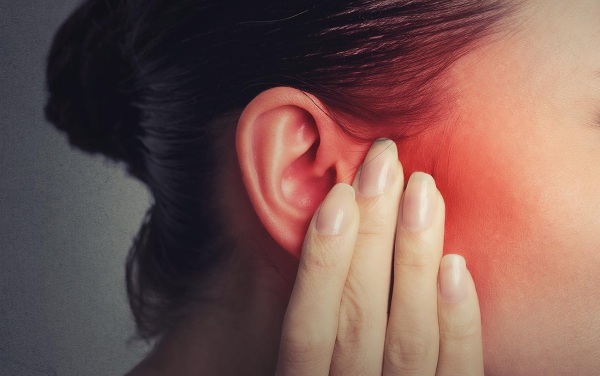
There are also factors that cause inflammation or dramatically increase the risk of developing it:
- hypothermia of the ear;
- moisture in the ear (after shower, bathing);
- reduced immunity;
- anomalies in the structure of the Eustachian tube;
- the presence of diabetes mellitus (people with this diagnosis are more susceptible to infectious and inflammatory diseases of the upper respiratory tract due to the fact that their immunity decreases);
- sudden changes in pressure;
- ear and tympanic membrane injuries;
- allergies (leads to swelling of the sinuses, which are associated with the ear canal);
- surgical interventions in the area of the ears and nose;
- inflammatory diseases of neighboring organs;
- excess sulfur in the ear (forms a sulfur plug in the ear canal);
- getting foreign objects into the ear (most often found in children);
- runny nose (due to the accumulation of mucus in the nostrils and nasal congestion, the equalization of pressure in the Eustachian tube is disturbed, which provokes damage to the structures of the ear and the development of the inflammatory process).
Some tourists, vacationing at resorts and diving in the sea or pool, often develop inflammation in the ear due to constant moisture in the ear canal and frequent pressure drops. The use of special solutions for rinsing the nose also increases the risk of inflammation - if the rinsing technique is not correct, the liquid can enter the ear.
Possible diseases
Ear inflammation (you cannot treat it yourself at home, so as not to cause complications) is a pathology called otitis media. There are several forms of the disease, depending on the location (the ear is divided into 3 sections), the duration of the course and the presence of exudate:
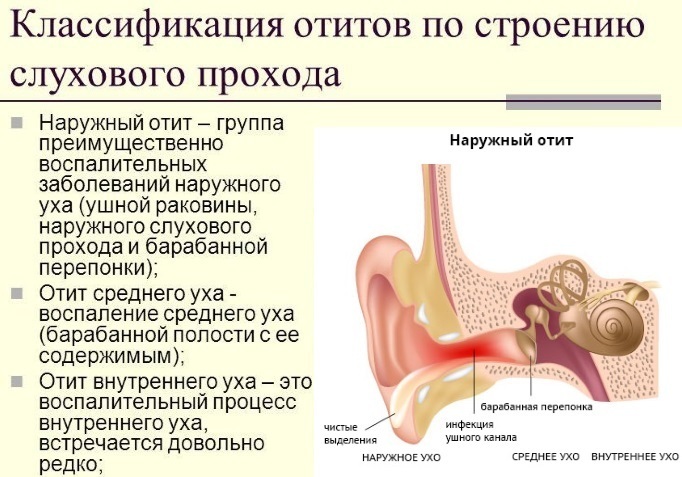
| Otitis externa | The inflammation is localized in the outer ear and does not affect the eardrum. Most often it develops due to insufficient ear hygiene or as a result of skin microtraumas. The main symptoms of otitis externa are pain (aggravated by pressure on the ear) and a feeling of ear congestion, redness of the auricle. |
| Otitis media | Otitis media is characterized by inflammation of the Eustachian tube and is most often the result of colds or infectious diseases. With otitis media, the formation of pus is characteristic, which does not flow out due to the eardrum and accumulates in the ear cavity, which causes symptoms:
|
| Internal otitis media (labyrinthitis) | This is the most dangerous form of otitis media that affects the cochlea and semicircular canals. This part of the ear is responsible for coordination, therefore, with internal otitis media, there is an imbalance and coordination of movements. Also, there is a sharp pain in the ear, fever, headache with dizziness and nausea, vomiting. The main cause of damage to the inner ear is untimely or improper treatment of otitis media. |
| Acute otitis media | The inflammatory process lasts no more than 1 month. |
| Chronic otitis media | The inflammatory process has a sluggish course and lasts more than 1 month. |
| Purulent otitis media | It is characterized by the formation of pus in the outer, middle, or inner ear. The most noticeable pus is in the outer ear - it has a white-yellow or greenish tint and flows from the ear canal. |
| Exudative otitis media | The formation of exudate (fluid) in the ear cavity is characterized.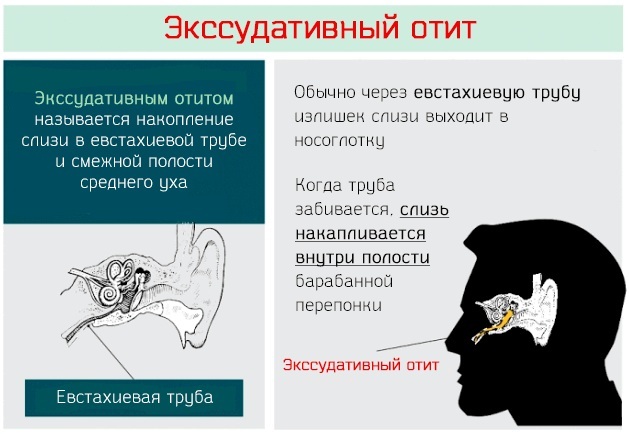
|
| Catarrhal otitis media | It is characterized by the absence of discharge from the ear canal. |
Also, otitis media can be a consequence of other infectious and inflammatory diseases of the ENT organs and not only:
- SARS, acute respiratory infections, flu, colds;
- sinusitis;
- tonsillitis;
- lymphadenitis (inflammation of the lymph node close to the ear).
In less common cases, inflammation can be caused by otomycosis (a fungal infection of the ear that can also affect the outer ear; middle and internal are usually not affected), Meniere's disease (non-suppurative inflammation, for which an increase in intra-aural fluid and intra-aural pressure is characteristic).
Diagnostics
The diagnosis and therapy of ear inflammation is carried out by an otorhinolaryngologist (ENT). He asks the patient about the symptoms (whether there is a temperature, hearing impairment) and examines the ear with an otoscope - a special a device with which you can detect the presence of inflammation and pus in the outer ear, changes in the structure of the tympanic membranes.
To assess the condition of the tympanic membrane, the quality of hearing and the detection of infiltration (pus or fluid) on average tympanometry is used in the ear - the doctor inserts the probe of the device into the ear canal and sends a sound wave to the drum membrane; the built-in probe sensor reads the reflected vibrations, stores them and gives the results in the form of a graph.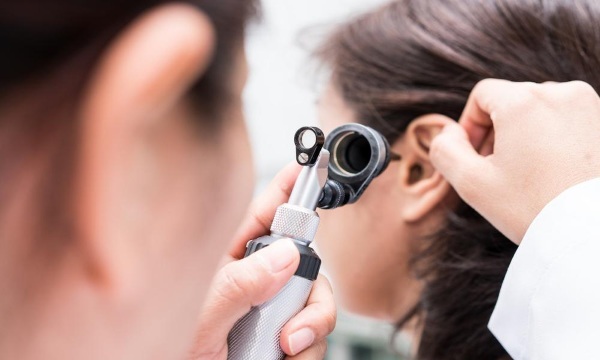
The following methods are used to diagnose otitis media of the inner ear:
- electronistamography - based on the registration of the movement of the eyeballs; helps to distinguish between dizziness caused by pathologies of the central nervous system and dizziness caused by labyrinthitis (different types of eye movements appear).
- vestibulometry - testing the functioning of the vestibular apparatus.
- MRI of the brain - to diagnose brain lesions that may result from otitis media.
Additionally, a bacteriological examination of the ear infiltrate is carried out - for this, the doctor with the help of a special needles draws pus or fluid from the ear, which is then examined to determine the kind of bacteria that caused infections. This is necessary for the selection of an effective antibiotic. If otomycosis is suspected, an ear swab is taken and examined for the presence of a fungus.
When to see a doctor
It is necessary to visit an otorhinolaryngologist when the first and main signs of inflammation appear: ear pain, hearing impairment and a feeling of fullness in the ear. Any discomfort in the ear and the area around it is a sign of pathology that can cause dangerous complications.
If a child complains of ear pain, and his ear turns red, then you should also immediately visit a pediatrician. In young children and infants, signs of ear inflammation are: redness of the auricle and ear canal, fever, and poor appetite.
Prophylaxis
You can prevent ear infection and the development of an inflammatory process in it by observing the following rules:
- do not allow water to enter the ears and after bathing, taking a shower, gently blot the auricle with a napkin;
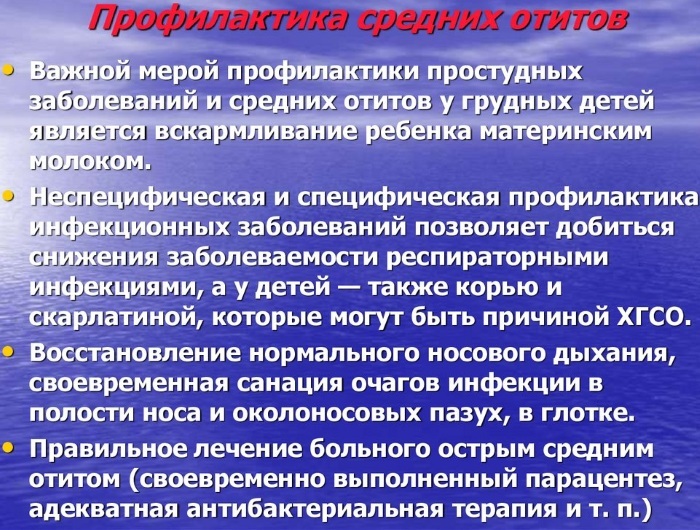
- when diving, it is recommended to use special earplugs to prevent water from entering the ears;
- do not scratch your ear with sharp nails and tools;
- when using cotton swabs, gently run them over the skin without injuring it;
- Take good care of your hearing aid and clean your headphones regularly.
- do not use other people's headphones;
- prevent hypothermia of the head, ears and the body as a whole;
- when cleaning the ears, leave a small amount of sulfur, as it has bactericidal properties.
Patients with diabetes mellitus need to strengthen the immune system, control blood sugar levels.
Treatment methods
Ear inflammation can only be treated at home if the outer and middle ear are affected. With internal otitis media, compulsory hospitalization is required - the patient undergoes therapy under the constant supervision of doctors.
The goal of therapy (regardless of the disease) is to eliminate pathogens, relieve pain and inflammation, restore hearing and prevent complications.
Medications
Ear inflammation at home is usually treated with medication.
For the treatment of inflammation caused by infectious otitis media, the following groups of drugs are prescribed:
| Group of drugs | Action | Release form | Names of funds |
| Antibiotics | Contribute to the destruction of infectious agents. | Ear drops, ointment | Ofloxacin, Neomycin, Otofa, Tetracycline ointment. |
| Non-steroidal anti-inflammatory drugs (NSAIDs) | They have an analgesic and anti-inflammatory effect, help to reduce temperature. | Pills | Ibuprofen, Nise. |
| Local anti-inflammatory drugs | Relieve inflammation and soreness in the ear. | Drops | Otipax, Otirelax. |
| Antiseptics | They have a bactericidal effect. | Drops, sprays | Boric alcohol, Miramistin. |
| Antihistamines | Contribute to the elimination of swelling of the tissues of the ear and nasopharynx. | Pills | “Tsetrin”, “Zodak”, “Suprastin”. |
| Vasoconstrictor drugs | They constrict blood vessels, thereby eliminating edema and redness of tissues. They are used in the ears or in the nose (since swelling of the nose can also affect the development of inflammation in the ear) | Drops | Xilen, Tizin, Rinostop. |

Additionally, the doctor may prescribe drugs to enhance immunity (Ascorbic acid, Viferon, Arbidol and vitamin-mineral complexes for general strengthening of the body.
With otomycosis, the same drug treatment regimen is used, but antibiotics are replaced with antifungal drugs in the form of tablets and rinsing solutions (depending on the specific type of fungus, which is established when taking smear).
Most often used "Fukortsin", Burov's liquid, "Clotrimazole". If the inflammation is caused by ARVI or ARI, then general treatment is carried out using anti-inflammatory drugs, antibiotics, vitamin complexes.
Traditional methods
Ear inflammation can be treated at home using traditional methods (always in combination with medications). The use of folk methods for otitis media and otomycosis helps to destroy the pathogenic flora in the ear, dissolve sulfur plugs, and eliminate painful sensations. Before using any product, you should consult your doctor.
It is also worth remembering that the ear should never be warmed up - this contributes to the spread of pus, an increase in edema and inflammation. Some folk methods involve warming up the ear (for example, using a hot compress with salt) and should never be performed.
Honey
Honey has anti-inflammatory and antibacterial properties.
For the treatment of otitis media, it must be used according to the following scheme:
- 1 hour l. honey must be dissolved in 70 ml of water at room temperature.
- Next, in the resulting solution, you should moisten a cotton turunda, squeeze and put it in your ear for 20 minutes.
- In 20 minutes. remove the tampon and gently blot the ear canal with a napkin.
Garlic
Garlic has a powerful bactericidal effect and helps to draw out pus. It is very simple to use it: you need to put a clove of garlic in your ear for 30-40 minutes, and then remove it. The procedure should be performed 1-2 times a day for 1 week.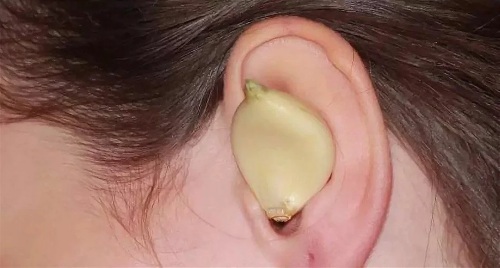
You can also squeeze juice from a clove of garlic, moisten a cotton swab in it and put it in your ear for 10-12 minutes. The procedure should be done once a day for 1 week.
Hydrogen peroxide
Hydrogen peroxide is a well-known disinfectant that also helps to cleanse the ear cavity of dirt and dust that provoke inflammation, and helps to dissolve and improve the removal of sulfur. It is necessary to make a turunda out of cotton wool or a cotton swab, moisten it in peroxide and put it in the ear for 5 minutes. The procedure must be done 2 times a day for 1 week.
Kalanchoe or aloe juice
The juice has anti-inflammatory and disinfectant effects. It must be ordered 2 drops 3 times a day for 2 weeks.
It must be ordered 2 drops 3 times a day for 2 weeks.
Herbal infusion
To prepare the broth, you will need 1 tbsp. l. dry chamomile flowers and sweet clover grass, as well as 200 ml of hot water.
Preparation and use process:
- The herbs must be mixed and covered with hot water for 30 minutes.
- Then the infusion must be filtered and cooled to a barely warm state.
- Next, you need to moisten a piece of cotton wool or cotton cloth in the solution, squeeze and apply to the ear and press the central part of the tissue into the ear canal.
- The compress must be kept for 20 minutes.
The course of treatment is 2 times a day for 2 weeks.
Apple vinegar
Apple cider vinegar is effective in treating fungal infections - it has a pronounced antifungal and antibacterial effect, relieves inflammation.
Scheme of use: it is necessary to mix 1 tsp. l. apple cider vinegar and water and soak a cotton swab or turunda in the resulting liquid. Then the turunda should be inserted into the ear for 5-7 minutes. Duration of use - 1 time per day for 10 days.
Decoction of bay leaves
A decoction of bay leaf helps to increase immunity (when used externally - local immunity), has antifungal and antiseptic effect. For its preparation you will need: 5-6 bay leaves, 300 ml of hot water.
Cooking process:
- Cover bay leaves with hot water and place the mixture on fire.
- Bring water to a boil and pour into a thermos.
- The broth should be infused in a thermos for 2 hours, then poured into another container and cooled.
You can store the broth in the refrigerator for 3 days, but it is recommended to prepare a new portion of the product daily.
Scheme of application: the broth should be instilled into the sore ear, 3 drops 3 times a day. At the same time, it must be taken orally in 1 tbsp. l. 3-4 times a day. The course of therapy is 10 days.
Decoction of birch buds
A decoction of birch buds has a disinfectant, anti-inflammatory, analgesic effect. It is used for bacterial and fungal infections. To prepare the broth, you will need 1 tsp. l. birch buds and 1 glass of hot water.
Cooking process:
- The raw material should be filled with water.
- Then the mixture must be put on low heat and brought to a boil.
- After boiling, the broth should be simmered over the fire for 2-3 minutes, then removed from the stove and cooled.
- After the broth has completely cooled, strain it.
It is recommended to use a medicinal decoction for otitis media in 2 ways:
- Outwardly - it is necessary to moisten a cotton swab in the broth, squeeze and put in the ear for 20 minutes. The course of treatment is 2 times a day for 2 weeks.
- Internally - 60-70 ml 3 times a day for 2 weeks.
Physiotherapy
Physiotherapy procedures are prescribed only after the complete elimination of the inflammatory process. The use of physiotherapy in the presence of inflammation can only aggravate the situation.
Physiotherapy procedures help to accelerate the regeneration of damaged tissues, normalize hearing and eliminate residual discomfort in the ears. Most often, UHF therapy, laser therapy or microcurrent treatment is prescribed.
Surgery
Surgical treatment is used in the following cases:
- ineffectiveness of conservative methods;
- progressive purulent otitis media;
- risk of hearing loss;
- direct danger of infection entering the brain area.
During the operation, the ear canal is sanitized - the internal cavity is cleaned and pus is pumped out. Then the ear cavity is treated with an antiseptic solution. If bone structures are involved in the inflammatory process, then a mastoidotomy is performed - trepanation of the mastoid process.
Possible complications
Since the ear is in close proximity to the brain, inflammation in the ear can spread to the organ area. This can lead to meningitis or brain abscess and can be fatal. Also, the danger is that pus or fluid from the ear can move to the brain and cause severe inflammation and subsequent neurological damage.
In addition, the inflammatory process in the ear, regardless of its occurrence, can lead to purulent inflammation of the mastoid process (mastoiditis), necrosis of the auditory ossicles, violations of the integrity of the tympanic membranes. In severe cases, partial or complete hearing loss, coordination disorders are possible.
With rapidly progressing otitis media, neuritis of the facial nerve is possible, which is fraught with paralysis or paresis.
In order to avoid the described complications, it is necessary to treat inflammation in the ear in a timely manner. The symptoms of pathology are easy to notice, since they are pronounced - it is important to immediately visit a doctor who will prescribe a suitable therapy. With an early visit to an otorhinolaryngologist, the success of treatment and complete recovery is the highest.
Ear inflammation is a dangerous pathology that in some cases can be fatal. Despite the fact that it is most often treated at home, a doctor must prescribe therapy. Otherwise, serious complications are possible.
Ear Inflammation Videos
Malysheva about otitis media:



